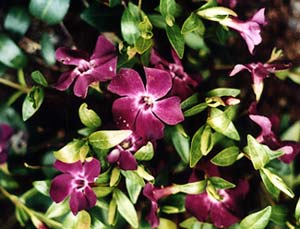
Wine Periwinkle; aka,
Magenta Creeping Myrtle
"Love! thy love pours down on mine
As the sunlight on the vine."
-George Meredith
(1828-1909)
(1828-1909)
Evergreen Vinca minor 'Atropurpurea' (occasionally called 'Rubra' or 'Purpurea') is a magenta, deep plum, or burgundy cultivar of the common periwinkle. It is sometimes called Wine Periwinkle. It is shown in a photo snapped in early April (2003). It grows together with some regular blue vinca along the edge of the sump-pump.
This variant color was discovered growing wild in Chiltington in Kent in the 1920s, & was soonafter grown for distribution by Mrs. Marion Cran, who was once very well known as an author & radio personality on gardening topics.
It thrives in partial to full shade, but here on Puget Sound also does very well in the sun. It likes moist well-drained soil, but also does well in surprisingly droughty conditions, as long as it gets rained on eventually.
Although Wine Periwinkle isn't as aggressive as the regular wild form, its creeping vines can clump up to six inches, which is not as thick & tall as the regular blue. It has an almost limitless spread, as it roots itself along its own vines, covering as much ground as it is permitted.
In folk belief, any vine of vinca brought into the house was unlucky unless it had at least seven flowers on it. One of the folk-names of Vinca minor is "Flower of Death" because it was woven into a band worn by dead children, & planted in particular on the gaves of infants, while in medieval times it was woven into crowns to be worn by criminals on the way to execution. In the 1600s it was called "Joy on the Ground," perhaps because it was also associated with love-making & the bond of marriage. Other British folk-names include Cockles, Cut-fingers, Blue-buttons, Pennywinkles, Creeping Myrtle, or in Scotland, Wilk. Playing off Periwinkle as meaning a little sea snail, the names Wilk & Cockle allude to sea animals. In Italy it has been known as Centocchio, the Hundred Eyes, alluding to its floweriness.
Its French name Pucellage means Virgin Flowers, & it was similarly known in English as Lady's Flower. These names associate the normal blue-flowering form with the blue veil or shawl of the Catholic Mary. The French also called it the Violette des sorciers knowing it was used as an aphrodisiac, for love-spells, or for repelling evil spirits. The association with love-magic & with the Virgin Mary echoes a far older association with Aphrodite & Cybele. The maenads or "raging women" of the ancient world wore garlands of vinca while rampaging in honor of Cybele.
It begins blooming in April & is most floriferous in spring. With ups & downs of intensity, it will continue bloming at least into September.
Compare this little vinca to the much larger
Vinca major
& see see the variegated form
Vinca major 'Maculata'
Vinca major
& see see the variegated form
Vinca major 'Maculata'